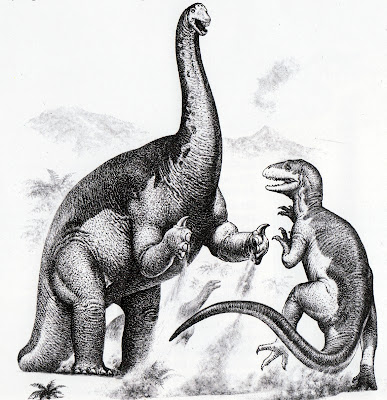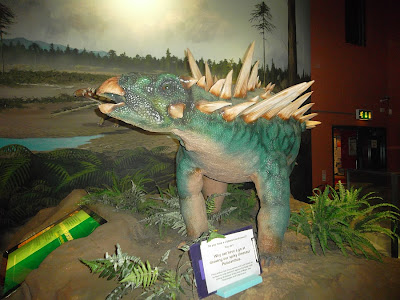Dinosaur Isle is a museum located in Sandown on the Isle of Wight (England). Sandown's an odd place - a crumbling relic of a seaside resort with a neglected, abandoned-looking art deco hotel (the 'Grand') and a
zoo fronted by the remains of a Second World War fortress (both of which happen to be located very close to the museum). The striking, angular frontage of the museum - intended to resemble a pterosaur - certainly stands in contrast with its surroundings, and on clear days is visible far down the coast.
But never mind all that - we're here for prehistoric beasties, and the museum doesn't disappoint.
Dinosaur Isle's a rare natural history museum in that, while it provides all the eye candy and 'interactivity' that modern museum audiences (and no-doubt adorable sugar-fuelled kiddiwinks) apparently demand, it doesn't skimp on genuine specimens and explanatory labelling. Guests are moved through the first part of the museum, conceived as a 'journey back in time', in a very linear fashion. In spite of the museum's name there is actually quite a large collection of Cenozoic material, which is very fascinating but which I completely neglected to photograph because I'm an idiot.
We are then treated to a life-size model of
Ophthalmosaurus, which is seemingly made out of
Walking With Dinosaurs leftovers. While this means it (inaccurately) has teeth, it's still a very nicely assembled diorama that also features some freaky 'uncoiled' ammonites (real specimens are on show nearby).
Of course, one really visits a place called Dinosaur Isle for the dinosaurs. The large, spacious main hall is very open, allowing guests to wander around at will and escape small children and their infuriatingly ignorant, confidently-spoken opinions that you really want to correct but daren't because their parents would give you funny looks, and the dad actually looks quite hard. Anyway, the first skeleton on show is this gloriously presented
Megalosaurus mount, surrounded by the approving smiles of the pioneers of palaeontology. Love it.
The two best-known Isle of Wight theropods are well represented by both real material and life-size models which - being over a decade old now - are already showing their age (such is the pace of palaeontological progress). The
Neovenator mount is impressive and, although behind glass, it is brightly-lit and allows for close inspection. Maybe the right leg is rather
too straight, but it's still pretty awesome.
The little model in the case would appear to be a recent addition and shows off the animal's characteristic twin-ridged skull, a trait common in allosaurs but missing from...
...the life-size animatronic model, which also, unfortunately, has bunny hands. It's impressive enough, although the movements are rather feeble and it emits
Jurassic Park T. rex roars, which is a bit cringey.
Eotyrannus also gets the life-size model treatment and, alas, also has bunny hands. Not sure if they'd get away with the lack of feathers these days, either, given
Dilong and
Yutyrannus. (And yes, Heinrich, OMG THE CAUDOFEMORALIS SHRINKAGE!!!11!!)
There's no mounted skeleton, but genuine
Eotyrannus fossils are on display nearby, which is very cool and provides the chance to inspect these wicked-looking phalanges.
To
Iguanodon now, the most famous English dinosaur that was actually Belgian. Actually, I believe fragmentary remains possibly belonging to
I. bernissartensis have been found on the Isle of Wight, but by far the better known iguanodontian from the island is the rather smaller
Mantellisaurus atherfieldensis. Regardless,
I. bernissartensis forms the basis of an impressively massive life restoration that has a convincingly stupid look on its fern-chomping face. There's also a sculpted complete skeleton and various fossil bits and pieces.
Happily, much love in the museum is given to
Hypsilophodon, with a mounted skeleton, various fossil specimens and a life-sized model. The mounted skeletons in London's Natural History Museum are tucked behind a
Euoplocephalus and are easily overlooked, but on its home island the little ornithopod gets a chance to shine.
That particular skull is on a turntable. The inclusion of the story detailing its discovery is quite typical, and it's a great touch that really adds a lot of colour. Notice also the diagrams.
The ankylosaur
Polacanthus is subject to a life restoration too, and it makes for an hilarious contrast with the Neave Parker-esque
monstrosity at Blackgang Chine. Dinosaur Isle presents a rare opportunity to actually see some remains from this beast, which nearby signage commendably notes is quite poorly known, with restorations often based on its relative
Gastonia. Check out the fragments of armour, including part of the hip shield (6).
How about some sauropod? The presentation (resembling a dig site, with a hard hat, notepad etc.) is a little twee (although it made me laugh), but once again the detailed description of the discovery and excavation of these fossils is very captivating, and too seldom seen in natural history museums.

There's a lot to see in this museum, and those put off by words like 'interactive' and 'experience' in the marketing claptrap needn't be - there's actually a huge collection of fossils on show, some unusually detailed signage, a bright and airy exhibition space and a very reasonable entry fee. What's perhaps best about this museum is that it successfully aims at the widest possible audience - sproglings and their disinterested progenitors can marvel at life-sized models and skeletal mounts, while dinosaur geeks can spend ages poring over both fossils and the descriptions that accompany them. What's more, its exhibitions change all the time (it currently plays host to part of Mark Witton & Co's Pterosaur Jamboree, originally displayed at the Southbank Centre, London) and there's a lot of surprising stuff squirreled away.
For example, the museum is apparently a retirement home for old Dorling Kindersley models.
...Not to mention John Sibbick's sketches.
Unfortunately, I happened to visit with someone rather nonplussed by dinosaurs who was tagging along through a sense of charity, hence my slightly scanty photographs. It's really worth going with someone who's as happy as you are to stick around and soak up every little detail. Yeah, there's some stuff that's a little awkwardly outdated (
Megalosaurus as a carnosaur...er...) - as per usual, but it's definitely worth a visit if you happen to be in that rather faded part of the world.
And finally, it's me with
Pteranodon.






































